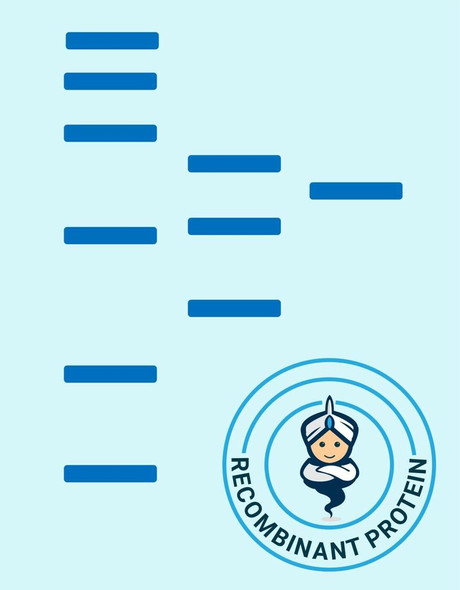Cytokines Recombinant Proteins
Human WISP2 Recombinant Protein (RPPB1095)
- SKU:
- RPPB1095
- Product Type:
- Recombinant Protein
- Species:
- Human
- Uniprot:
- O76076
- Research Area:
- Cytokines
Description
| Product Name: | Human WISP2 Recombinant Protein |
| Product Code: | RPPB1095 |
| Size: | 20µg |
| Species: | Human |
| Target: | WISP2 |
| Synonyms: | WNT1 Inducible Signaling Pathway Protein 2, Connective Tissue Growth Factor-Related Protein 58, Connective Tissue Growth Factor-Like Protein, CCN Family Member 5, CTGF-L, CT58, CCN5, WISP-2, CTGFL, WISP2. |
| Source: | Escherichia Coli |
| Physical Appearance: | Sterile Filtered White lyophilized (freeze-dried) powder. |
| Formulation: | Lyophilized from a sterile (0.2�m) filtered aqueous solution containing 0.1% Trifluoroacetic Acid (TFA). |
| Solubility: | It is recommended to reconstitute the lyophilized WISP-2 in sterile 10mM acetic acid not less than 100�g/ml, which can then be further diluted to other aqueous solutions. |
| Stability: | Lyophilized WISP2 although stable at room temperature for 3 weeks, should be stored desiccated below -18°C. Upon reconstitution WISP-2 should be stored at 4°C between 2-7 days and for future use below -18°C.For long term storage it is recommended to add a carrier protein (0.1% HSA or BSA).Please prevent freeze-thaw cycles. |
| Purity: | Greater than 95.0% as determined by SDS-PAGE. |
| Amino Acid Sequence: | MQLCPTPCTC PWPPPRCPLG VPLVLDGCGC CRVCARRLGE PCDQLHVCDA SQGLVCQPGA GPGGRGALCL LAEDDSSCEV NGRLYREGET FQPHCSIRCR CEDGGFTCVP LCSEDVRLPS WDCPHPRRVE VLGKCCPEWV CGQGGGLGTQ PLPAQGPQFS GLVSSLPPGV PCPEWSTAWG PCSTTCGLGM ATRVSNQNRF CRLETQRRLC LSRPCPPSRG RSPQNSAF |
WNT1-inducible-signaling pathway protein 2 (WISP2) belongs to the WNT1 inducible signaling pathway (WISP) protein subfamily, which belongs to the connective tissue growth factor (CTGF) family. The CTGF family members are characterized by 4 conserved cysteine-rich domains: insulin-like growth factor-binding domain, von Willebrand factor type C module, thrombospondin domain and C-terminal cystine knot-like (CT) domain. WISP2 protein lacks the CT domain which is implicated in dimerization binding. WISP2 is possibly involved in bone remodeling. WISP2 is expressed in primary osteoblasts and fibroblasts. WISP2 stimulates osteoblast adhesion and inhibits osteocalcin production. WISP2 expression in colon tumors is reduced while the other 2 WISP members are overexpressed in colon tumors. WISP2 may play an imperative role in modulating bone turnover.
WISP2 Human Recombinant produced in E.coli is a single, non-glycosylated polypeptide chain containing a total of 228 amino acids and having a molecular mass of 24.4kDa.
| UniProt Protein Function: | WISP2: May play an important role in modulating bone turnover. Promotes the adhesion of osteoblast cells and inhibits the binding of fibrinogen to integrin receptors. In addition, inhibits osteocalcin production. Belongs to the CCN family. |
| UniProt Protein Details: | Protein type:Secreted; Secreted, signal peptide Chromosomal Location of Human Ortholog: 20q13.12 Cellular Component: extracellular space; proteinaceous extracellular matrix; plasma membrane Molecular Function:heparin binding; integrin binding; insulin-like growth factor binding Biological Process: cell-cell signaling; regulation of cell growth; signal transduction; cell adhesion |
| NCBI Summary: | This gene encodes a member of the WNT1 inducible signaling pathway (WISP) protein subfamily, which belongs to the connective tissue growth factor (CTGF) family. WNT1 is a member of a family of cysteine-rich, glycosylated signaling proteins that mediate diverse developmental processes. The CTGF family members are characterized by four conserved cysteine-rich domains: insulin-like growth factor-binding domain, von Willebrand factor type C module, thrombospondin domain and C-terminal cystine knot-like (CT) domain. The encoded protein lacks the CT domain which is implicated in dimerization and heparin binding. It is 72% identical to the mouse protein at the amino acid level. This gene may be downstream in the WNT1 signaling pathway that is relevant to malignant transformation. Its expression in colon tumors is reduced while the other two WISP members are overexpressed in colon tumors. It is expressed at high levels in bone tissue, and may play an important role in modulating bone turnover. [provided by RefSeq, Jul 2008] |
| UniProt Code: | O76076 |
| NCBI GenInfo Identifier: | 24211561 |
| NCBI Gene ID: | 8839 |
| NCBI Accession: | O76076.1 |
| UniProt Secondary Accession: | O76076,Q6PEG3, B2R9N4, E1P612, |
| UniProt Related Accession: | O76076 |
| Molecular Weight: | Observed: 27kDaCalculated: 22kDa/26kDa |
| NCBI Full Name: | WNT1-inducible-signaling pathway protein 2 |
| NCBI Synonym Full Names: | WNT1 inducible signaling pathway protein 2 |
| NCBI Official Symbol: | WISP2�� |
| NCBI Official Synonym Symbols: | CCN5; CT58; CTGF-L�� |
| NCBI Protein Information: | WNT1-inducible-signaling pathway protein 2; WISP-2; CCN family member 5; wnt-1 signaling pathway protein 2; connective tissue growth factor-like protein; connective tissue growth factor-related protein 58 |
| UniProt Protein Name: | WNT1-inducible-signaling pathway protein 2 |
| UniProt Synonym Protein Names: | CCN family member 5; Connective tissue growth factor-like protein; CTGF-L; Connective tissue growth factor-related protein 58 |
| Protein Family: | WNT1-inducible-signaling pathway protein |
| UniProt Gene Name: | WISP2�� |
| UniProt Entry Name: | WISP2_HUMAN |






